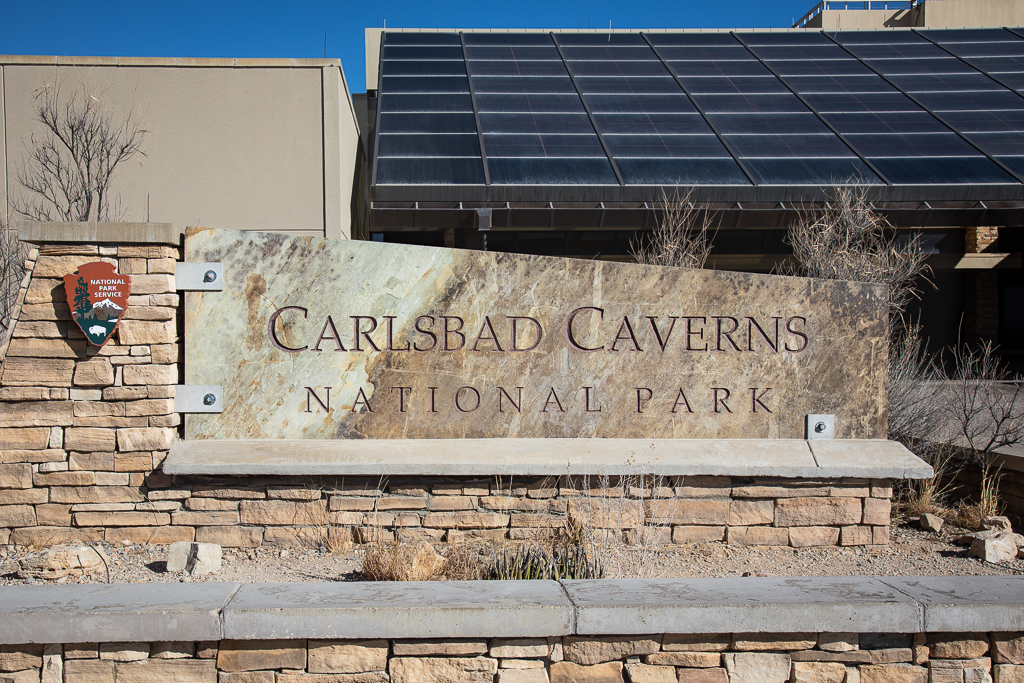
After Elephant Butte, we headed to Carlsbad Caverns via El Paso, Texas. El Paso’s traffic on I-10 seemed crazy-busy to us compared to Albuquerque or Santa Fe. No surprise, since the El Paso-Juárez area is home to about 2.7 million people, where the Albuquerque metro is about 1.2 million. The area is also home to the U.S. Army’s Fort Bliss, which houses about 11,000 people.
The city is directly across the border from Ciudad Juárez, Chihuahua, and is one of the busiest border crossings between the U.S. and Mexico. World Atlas says that “In 2018, 12.4 million personal vehicles carrying more than 22 million passengers used the border crossing.”

At one point while driving on I-10, one can see across the Rio Grande into Ciudad Juárez. If you look closely, you can see the border fence just on the other side of the underpass.

While we were only in El Paso for a very short time, I noticed that there is a subculture of low-rider pickup trucks. They share the common themes of usually being Chevys or GMCs, are very loud, have blacked out windows, and have misogynistic and often vulgar stickers on their windows. Here’s one of the more tame examples of said stickers.

Driving across the desert on Highway 62, we re-entered New Mexico just south of Carlsbad. We checked into the campground at White’s City, where there were some foreigners to greet us.

Inside the gift shop, there were some barstools for sale. We had been looking for some new barstools, but these weren’t exactly what we had in mind, though they were pretty funny.
The next morning we headed for the Caverns. After squaring away Koda in the Park’s kennel for the morning, we purchased our tickets to descend into the caverns. There are two ways to make the descent: Take an elevator, or a one-hour-plus hike down to about 650 ft below the surface, which is called the Natural Entrance. I chose to take the walk down, Rozanne opted for the elevator.
In retrospect, I don’t think the walk down was as impressive as the features in the Big Room (pictures later). There were some interesting things, but what I liked most was that I was following a similar path that Jim White took oh-so-many years ago.
Tip: The path is steeply downhill in places, and sometimes wet and slippery. Lace up your shoes tightly to keep your toes from being smooshed into the front of your shoes. I couldn’t get my laces tight enough because I was wearing thin socks that day. I am a big fan of shoes with Vibram rubber soles because they have outstanding “grippiness” on slick surfaces. There are many places on the walks throughout the caverns that are covered in a film of water.
Toward the end of the descent, I was really looking forward to flat ground to give my feet a break, which I found only when I got to the bottom in the Big Room. Was it worth the discomfort for the descent? I’d say yes, but I’ll wear better socks next time.

The Natural Entrance is the way that the caverns were originally discovered in 1898 by teenager Jim White. Jim had observed what appeared to be a volcano or tornado, but was actually a swarm of bats, and went to investigate. He found the hole in the ground and is to have said “I found myself gazing into the biggest and blackest hole I had ever seen, out of which the bats seemed literally to boil.” It is estimated that over 700,000 bats have lived in the caverns at one time, though the population is now estimated at around 4-500,000. The National Park Service holds programs from Memorial Day through October where people can observe the bats exiting the cavern entrance around sunset.

Once down into the caves, the main attraction is simply called the “Big Room,” which was named by Jim White. He named many of the features inside the Big Room, as well as other rooms in the cave system. The Big Room is about 4000 feet long, 625 feet wide, and 255 feet high. The cave formations are lit from underneath with gold-colored LEDs. Cell phone photos tend to incorrectly adjust the photos to look more like white light.


The Caverns are an amazing place, well worth the out-of-the-way drive from El Paso and Albuquerque. The scale of the Big Room and the huge formations in it are hard to portray in photographs, so we tried to include people in some of the photos when possible. The magical shapes formed solely by sometimes running — but always simply dripping — water over millenia are stunning. The Cavern ceilings have gained an arch shape now and are geologically stable enough to resist cave-ins from earthquakes, yet the formations they contain continue to change and grow.













Marie Cary | 9th Mar 22
Omg, looks prehistoric. How amazing to see in person.